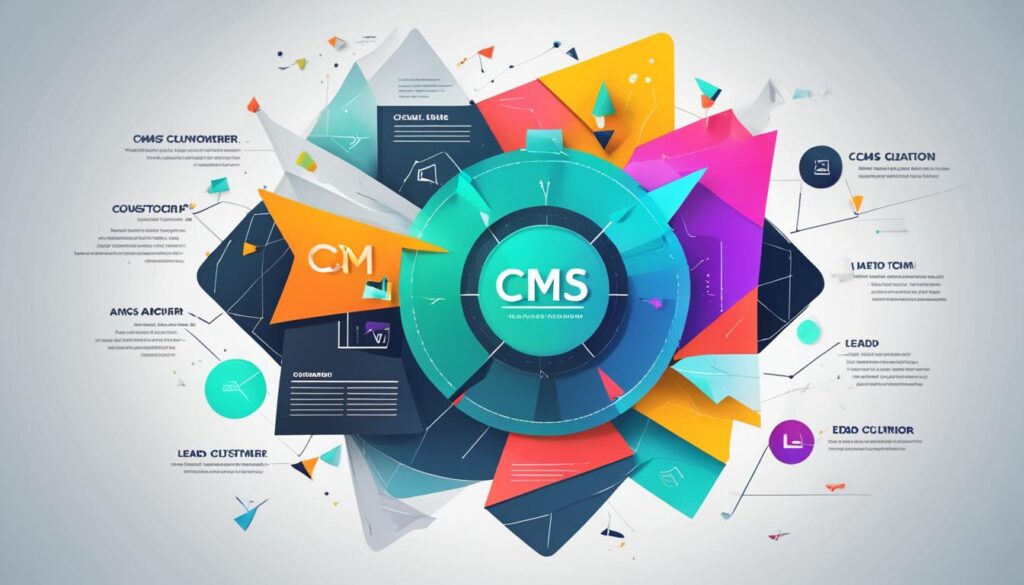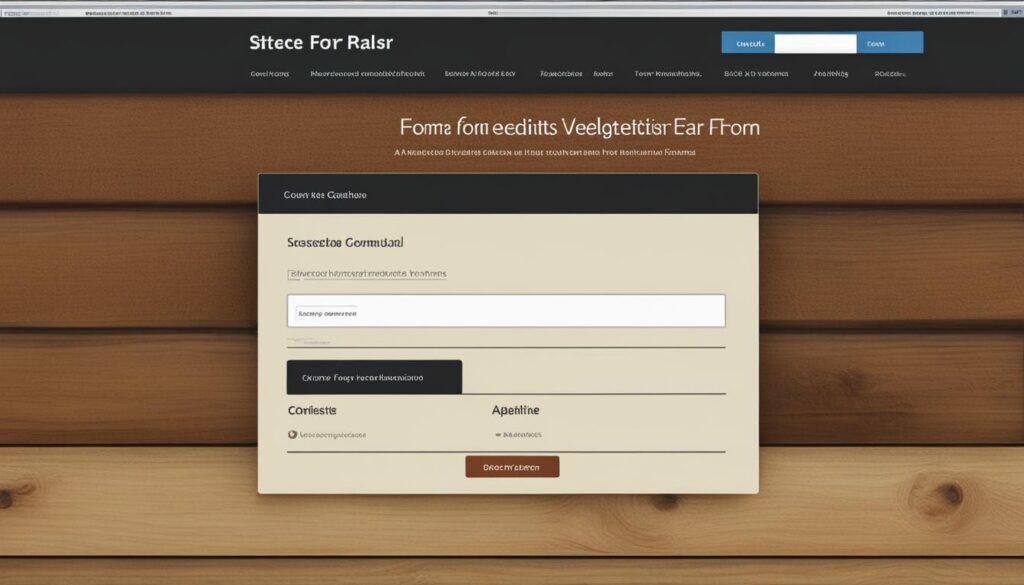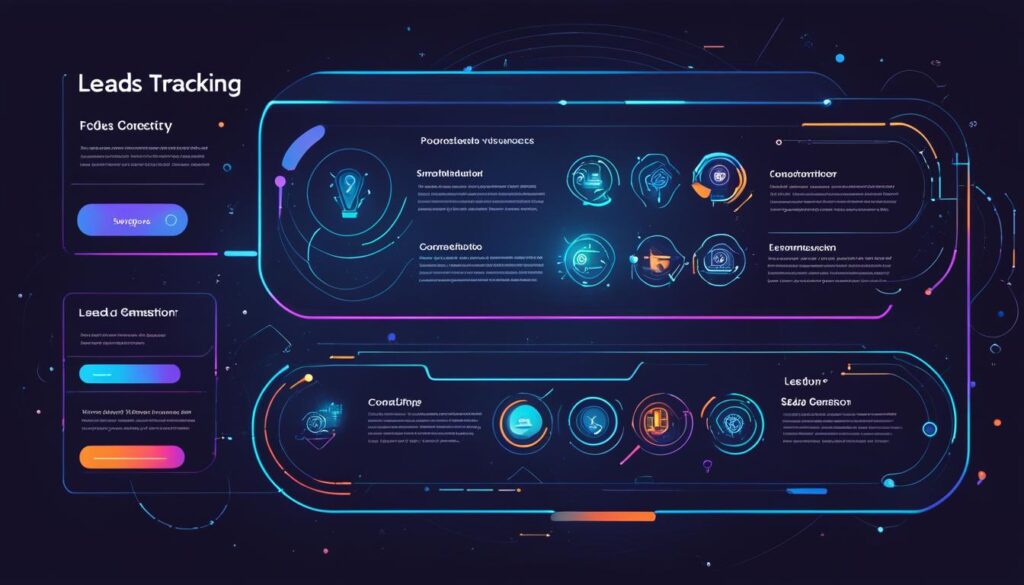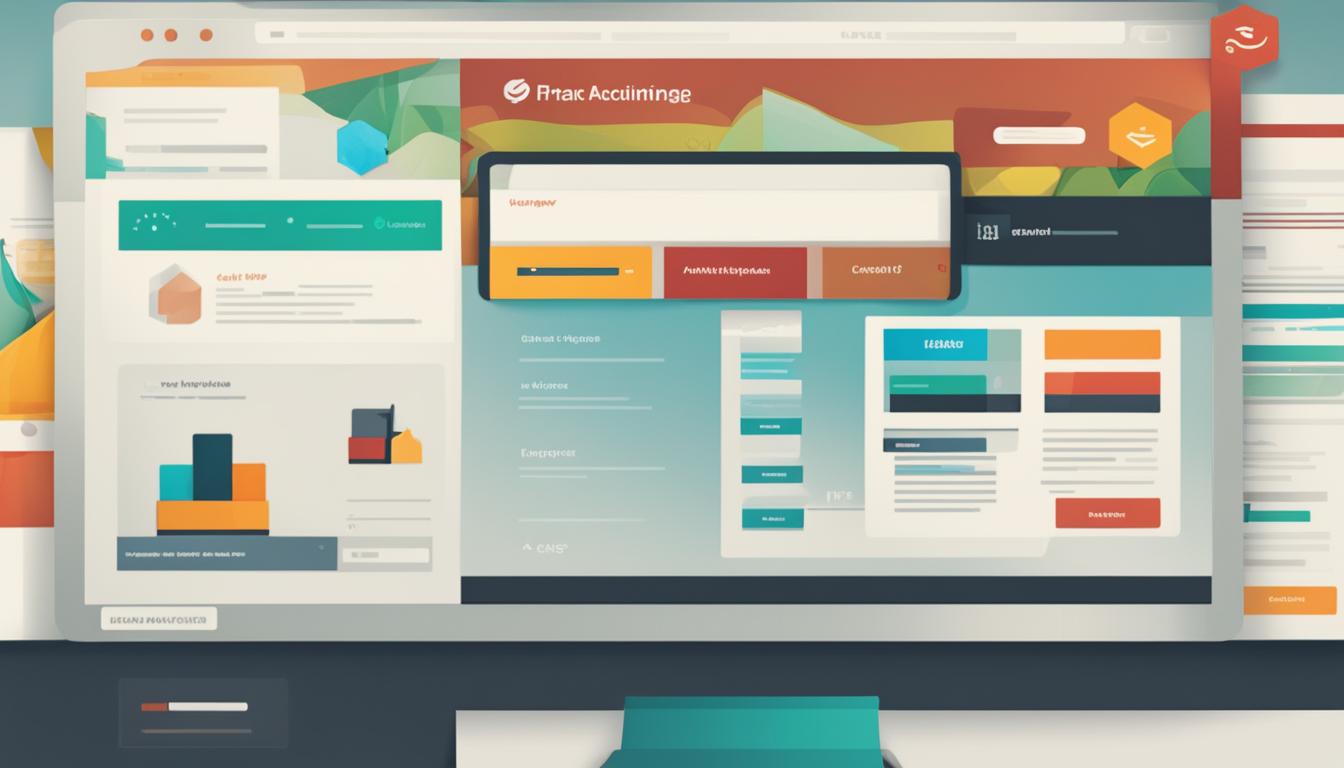Are you looking to generate more leads for your business? A well-designed website can be a powerful tool for lead generation. By strategically optimizing your website design, you can create a lead generation website that captures visitor information and drives business growth.
In this article, we will explore effective web design strategies to maximize leads and take your lead generation efforts to the next level. From understanding the lead generation process to setting goals, choosing the right CMS tool, and building compelling landing pages, we will cover everything you need to know to create a lead generation optimized website.
With the right web design strategies in place, you can create a website that attracts and engages visitors, captures their information, and converts them into valuable leads. So, let’s dive in and discover how to optimize your website design for lead generation.
Key Takeaways:
- Optimizing your website design is crucial for lead generation.
- Understanding the lead generation process is essential to maximize leads.
- Set clear goals for your lead generation website to drive results.
- Choose the right CMS tool that aligns with your lead generation needs.
- Building effective landing pages can significantly increase lead conversions.
Understanding the Lead Generation Process
To optimize your website for lead generation, it’s important to understand the lead generation process. This process typically starts with a website visitor clicking on a call-to-action (CTA) that leads them to a landing page. On the landing page, there is a form where the visitor can submit their contact information. After submitting the form, they are redirected to a thank-you page. By following this process, you can capture leads and move them through the sales funnel.
The Lead Generation Process
- Website Visitor: A potential lead arrives on your website.
- Call-to-Action (CTA): The visitor is prompted to take action, such as signing up for a newsletter or requesting a free consultation.
- Landing Page: The visitor is directed to a dedicated landing page where they can find more information about the offer.
- Form: On the landing page, the visitor fills out a form with their contact information, such as name and email address.
- Thank-You Page: After submitting the form, the visitor is redirected to a thank-you page that acknowledges their submission and provides any additional instructions or resources.
By guiding website visitors through this lead generation process, you can effectively capture their information and nurture them as potential customers. Let’s dive deeper into each step of this process:
“The lead generation process is like a journey for both the visitor and the business. It starts with a simple interaction on a website and ends with a potential business opportunity. Understanding this process allows us to optimize it for maximum effectiveness.”
Maximizing Lead Generation with Effective Landing Pages
Landing pages play a crucial role in the lead generation process. They serve as the gateway for visitors to access your offer and provide their contact information. When designing landing pages, focus on creating a clear and compelling headline that captures attention. Use persuasive copy to highlight the benefits of your offer and entice visitors to take action. Including visuals, such as product images or infographics, can also enhance engagement.
A strong call-to-action (CTA) is essential on landing pages. Clearly communicate what action you want visitors to take, whether it’s signing up for a trial, downloading a guide, or scheduling a consultation. Make the CTA button stand out by using contrasting colors and persuasive copy.

Example of an Effective Landing Page:
| Key Elements | Description |
|---|---|
| Compelling Headline | Use attention-grabbing words to clearly communicate the value proposition of your offer. |
| Informative Copy | Explain the benefits of your offer and address any potential concerns or objections. |
| Visuals | Include relevant images or videos that support your offer and engage visitors. |
| Clear Call-to-Action | Create a prominent CTA button with persuasive copy that prompts visitors to take the desired action. |
By understanding the lead generation process and optimizing each step, you can create an effective website that generates valuable leads. Next, we will explore how to set goals for your lead generation website and utilize the right CMS tool to drive optimal results.
Setting Goals for Your Lead Generation Website
Before building your lead generation website, we need to establish clear goals that align with your business objectives. By defining your lead generation goals, we can create a website that effectively captures leads and drives conversions.
One common website goal for lead generation is educating potential buyers. By providing valuable content and resources, you can position your brand as an industry authority and build trust with your audience. Consider creating free resources like ebooks, whitepapers, or how-to guides that visitors can download in exchange for their contact information. These resources not only educate buyers but also serve as lead magnets, enticing visitors to provide their details through sign-up forms.
Another goal for your lead generation website may be to increase sign-ups or subscriptions. In this case, strategically placed landing pages with compelling offers and strong calls-to-action (CTAs) can prove highly effective. Your landing pages should clearly communicate the benefits of signing up or subscribing and showcase a strong CTA button that prompts visitors to take action.
Benefits of Setting Goals:
- Aligns your website design and content with your business objectives
- Allows for targeted and strategic creation of valuable resources
- Enables tracking and measurement of lead generation success
We need to remember that setting specific lead generation goals enables us to focus our efforts on what truly matters: capturing high-quality leads and ultimately driving business growth.
By setting goals for your lead generation website, you pave the way for success. Whether it’s educating buyers or increasing sign-ups, understanding your website’s purpose allows you to design a compelling user experience that guides visitors towards conversion. So, let’s move forward and start building your lead generation website that aligns with your business goals.

Choosing the Right CMS Tool for Lead Generation
When it comes to creating a lead generation website, selecting the right CMS tool is crucial for success. A CMS tool, or Content Management System, provides the foundation for your website’s design, functionality, and user experience. By choosing a CMS tool that aligns with your lead generation objectives, you can effectively capture and nurture leads to drive business growth.
So, what should you look for in a CMS tool for lead generation? Here are some key considerations:
1. Built-in Lead Generation Optimizations
A reliable CMS tool should offer built-in features and optimizations specifically geared towards lead generation. Look for tools that provide seamless integration of lead capture forms, email marketing capabilities, live chat functionality, and robust analytics. These features enable you to engage with your audience effectively and capture valuable lead data.
2. User-Friendly Website Development
If you don’t have website development or coding experience, choosing a CMS tool with user-friendly website development features is essential. Look for drag-and-drop capabilities or built-in themes that simplify the website creation process. This way, you can focus on designing an engaging lead generation website without the need for extensive coding knowledge.
3. Customizable Forms and Landing Pages
Forms play a crucial role in lead generation, as they allow visitors to provide their contact information. Choose a CMS tool that allows you to create and customize forms easily. Look for options to add form fields, personalize form designs, and integrate email notifications for prompt follow-up. Additionally, a CMS tool with the ability to create attractive landing pages with strong calls-to-action (CTAs) can significantly enhance your lead generation efforts.
4. Seamless Email Marketing Integration
Email marketing is a powerful tool for nurturing leads and guiding them through the sales funnel. Ensure that the CMS tool you choose offers seamless integration with popular email marketing platforms. This integration allows you to automate lead nurturing campaigns, send targeted emails based on user behavior, and track the effectiveness of your email marketing efforts.
5. Responsive Design and Mobile Compatibility
In today’s mobile-centric world, it’s essential for your lead generation website to have responsive design and mobile compatibility. Choose a CMS tool that offers responsive templates and ensures that your website looks great and functions seamlessly across various devices and screen sizes.

Choosing the right CMS tool for lead generation is crucial to the success of your online marketing efforts. By considering the factors mentioned above and selecting a CMS tool that caters to your specific lead generation needs, you can effectively capture leads and maximize your business growth potential.
Building Effective Landing Pages
Landing pages play a crucial role in lead generation websites. When creating landing pages, our primary focus should be on engaging visitors and motivating them to take action. By incorporating key elements such as a compelling headline, informative copy, showcasing benefits, and a strong call-to-action (CTA) button, we can create landing pages that significantly increase lead conversions.
Compelling Headline
A compelling headline is the first impression visitors have of your landing page. It should grab their attention and clearly communicate the value of your offer. Use enticing language and highlight the primary benefit to create curiosity and encourage further exploration.
“Discover the Secret to Doubling Your Sales with our Revolutionary Sales Funnel Optimizer!”
Informative Copy
The copy on your landing page should provide relevant information about your product or service. Clearly explain how it solves a problem or fulfills a need for the visitor. Use concise and persuasive language to convey the key features and benefits that set your offering apart.
“Our Sales Funnel Optimizer is specifically designed to help businesses maximize their sales potential. By identifying bottlenecks and streamlining the customer journey, you can significantly increase your conversion rates and revenue.”
Showcasing Benefits
Highlighting the benefits of your product or service is crucial in capturing visitor interest. Clearly communicate the positive impact it can have on their lives or business. Use bullet points or a concise list format to present the key benefits in an easily scannable and digestible way.
- Boost sales by streamlining your sales funnel
- Increase conversion rates and revenue
- Identify and eliminate bottlenecks
- Maximize the value of your marketing efforts
Product Image
An attractive and relevant product image helps to enhance the visual appeal of your landing page. Include a high-quality image that showcases your product or represents the solution you’re offering. This can help build trust and credibility, and also provide a visual representation of the benefits you’re promoting.

Strong Call-to-Action (CTA) Button
The CTA button is the critical element that prompts visitors to take action. Use action-oriented and persuasive language on the button to encourage clicks. Make sure it stands out visually in terms of color, size, or placement on the page to draw attention and compel visitors to click and convert.
Get Started Now!
By following these best practices for building effective landing pages, we can create a compelling user experience that drives higher lead conversions and ultimately contributes to the growth of our business.
Increasing Leads with Form Placement
When it comes to lead generation, strategic form placement can make all the difference. By analyzing your lead generators and identifying the pages that receive the most online traffic, you can optimize your website for maximum lead generation potential.
One effective strategy is to strategically place forms on high-traffic pages. These forms act as lead capture tools, allowing you to gather valuable visitor information and convert them into potential customers. Consider placing forms prominently on pages that consistently attract a large number of visitors, such as your homepage or popular blog posts.
“Strategically placing forms on high-traffic pages can significantly increase your lead capture rates, providing you with a steady stream of potential customers.”
To further engage visitors and encourage form submissions, consider offering long-form content that can be accessed through the forms. This could include in-depth guides, e-books, or industry reports. By providing valuable content in exchange for their contact information, you can increase visitor engagement and generate more leads.
Remember, the key to effective form placement is understanding your target audience and their browsing behavior. By analyzing your website analytics and tracking user behavior, you can identify the pages that have the highest conversion rates and strategically place forms on those pages.
By optimizing your form placement strategy, you can effectively generate more leads and increase your chances of converting visitors into customers.

| Benefits of Strategic Form Placement: |
|---|
| 1. Increased lead capture rates |
| 2. Enhanced visitor engagement |
| 3. More targeted lead generation |
| 4. Valuable insights into customer behavior |
| 5. Higher conversion rates |
Measuring and Improving Lead Generation Performance
To ensure the success of your lead generation strategies, it is crucial to measure and improve your lead generation performance. By analyzing data and optimizing your lead generators, landing pages, CTAs, and overall conversion rate, you can maximize your lead generation efforts and drive business growth.
One effective way to measure your lead generation performance is by utilizing analytics tools such as Website Grader. This tool enables you to track key performance indicators (KPIs) and gain insights into the effectiveness of your lead generation efforts. By monitoring metrics like website traffic, bounce rate, conversion rate, and time on page, you can identify areas for improvement and make informed decisions to optimize your performance.
Comparing High-Performing Landing Pages
When analyzing your lead generation performance, it is essential to compare your landing pages. Identify the landing pages that are generating the most leads and have high conversion rates. By studying these high-performing landing pages, you can uncover valuable insights and apply successful elements to other pages.
Focus on elements such as compelling copy, persuasive CTAs, engaging visuals, and user-friendly forms. A well-designed landing page that effectively communicates your value proposition and captures visitors’ attention can significantly increase your lead generation performance.
A/B Testing for Continuous Improvement
A/B testing, also known as split testing, is an invaluable tool for improving your lead generation performance. By testing different versions of your CTAs, landing pages, and thank-you pages, you can identify what resonates most with your audience and generates the highest conversion rates.
Start by testing small changes such as CTA button design, placement, or text. Gradually move on to testing different variations of landing page layouts, content, and form fields. Be sure to monitor the results and collect data to determine which variations perform better and drive higher conversion rates.
Optimizing Conversion Funnel with Data-Driven Insights
By continuously measuring and analyzing data from your lead generation campaigns, you can gain valuable insights into your conversion funnel. Identify bottlenecks or areas where potential leads are dropping off and make the necessary adjustments to optimize their journey.
Use analytics tools to track visitor behavior, click-through rates, engagement levels, and conversion rates at each stage of the funnel. With these insights, you can refine your CTAs, landing pages, and follow-up processes to improve lead nurturing and increase conversions.
| Benefit | Explanation |
|---|---|
| Higher Conversion Rates | Optimizing your lead generation performance leads to higher conversion rates. By analyzing data and making data-driven improvements, you can create a more effective lead generation process that converts more prospects into leads. |
| Improved ROI | Maximizing the effectiveness of your lead generation efforts means getting more value from your investment. By continuously measuring and improving your performance, you can increase your return on investment (ROI) and generate more business opportunities. |
| Enhanced Customer Insights | Through analytics and A/B testing, you gain valuable insights into your target audience’s preferences and behaviors. This data allows you to tailor your lead generation strategies to effectively engage and convert your ideal customers. |
By implementing a data-driven approach to measuring and improving your lead generation performance, you can optimize your efforts to generate more qualified leads and achieve greater business success.

Optimizing the Lead Generation Process
Attracting potential leads is only the first step. To maximize conversions, it’s essential to optimize each step of the lead generation process. By fine-tuning your conversion path, conducting A/B testing, and enhancing your CTAs, landing pages, thank-you pages, and kickback emails, you can significantly increase the effectiveness of your lead generation efforts.
Captivating CTAs and Engaging Landing Pages
When designing your CTAs and landing pages, it’s crucial to align them with your visitors’ initial search intent and capture their interest. Craft compelling CTAs that clearly convey the value of your offer and encourage action. Your landing pages should have persuasive copy, highlighting the benefits and value proposition of your product or service. Utilize captivating visuals, such as product images or relevant infographics, to enhance the visual appeal.
By ensuring a seamless user experience and providing valuable content, you can increase the likelihood of visitors becoming leads. Consider the following checklist when optimizing your CTAs and landing pages:
- Create clear and concise CTAs that clearly state the desired action
- Use powerful and action-oriented language to drive conversions
- Optimize landing page copy to highlight key benefits and solutions
- Include relevant visuals to enhance engagement and understanding
- Design a user-friendly layout for easy navigation and form submission
A/B Testing for Continuous Improvement
A/B testing is an invaluable tool for optimizing your lead generation process. By experimenting with different elements of your CTAs, landing pages, thank-you pages, and kickback emails, you can unlock insights into what resonates best with your audience and drives higher conversions.
Here are some elements to consider when conducting A/B tests:
- Vary your CTA design, placement, color, and text
- Test different headlines and copy on your landing pages
- Experiment with different form lengths and required fields
- Try different approaches for thank-you pages, such as offering additional resources or upsells
- Personalize kickback emails based on the lead’s interests or behaviors
Remember, A/B testing should be an ongoing process. Continuously analyze the data and adjust your strategies to optimize conversions based on the insights gained.

Analyze and Refine the Conversion Path
Mapping out and optimizing the conversion path is essential for reducing friction and improving lead generation effectiveness. Consider the following steps when optimizing your conversion path:
- Identify potential roadblocks or bottlenecks in the conversion process
- Streamline the user journey by minimizing the number of steps and form fields
- Ensure that all touchpoints are consistent and aligned with your brand messaging
- Use clear and compelling messaging to guide visitors through each stage of the conversion path
By continuously refining and optimizing your conversion path, you can create a smoother and more seamless experience for your visitors, ultimately increasing your lead generation effectiveness.
| Optimization Strategy | Benefits |
|---|---|
| Alignment with visitor search intent | Improved relevance and higher click-through rates |
| Engaging and persuasive landing pages | Higher conversion rates and increased lead quality |
| A/B testing | Insights into audience preferences and improved conversion rates |
| Optimized conversion path | Reduced friction, increased lead flow, and improved user experience |
By leveraging these optimization strategies, you can enhance your lead generation process and unlock the full potential of your website as a lead generation powerhouse.
Designing for Trust and Credibility
Building trust and credibility is crucial for lead generation. When visitors come to your website, they need reassurance that they can trust your brand and feel confident in sharing their information with you. Incorporate the following trust signals to establish credibility:
- Customer Testimonials: Highlight positive feedback from satisfied customers. Include their name, company, and a brief testimonial expressing their experience with your product or service.
- Ratings and Certifications: If your business has received any industry certifications or recognition, prominently display them on your website to convey expertise and trustworthiness.
- Security Badges: Assure visitors of their data security by displaying trust seals or security badges from reputable organizations.
Add clear contact information to your website to establish accessibility and transparency:
- Phone Numbers: Display a phone number where visitors can reach your team for inquiries or assistance.
- Email Addresses: Provide an email address dedicated to customer inquiries or support.
- Physical Address: If applicable, include your business’s physical address to instill confidence in your local presence.
Implement a privacy policy to assure visitors that their data will be handled with utmost security and confidentiality. Your privacy policy should clearly outline how you collect, use, and protect personal information. By showcasing your credibility and commitment to customer trust, you can generate more leads and build lasting relationships.
| Trust Signals | Contact Information | Privacy Policy |
|---|---|---|
| Customer Testimonials | Phone Numbers | Information Security |
| Ratings and Certifications | Email Addresses | Data Handling |
| Security Badges | Physical Address | Confidentiality |
By incorporating these trust signals, providing clear contact information, and implementing a privacy policy, your lead generation website will inspire confidence in visitors and encourage them to take action.
Conclusion
By implementing effective web design strategies, you can create a lead generation website that maximizes leads and drives business growth. Understanding the lead generation process and optimizing each step, from capturing visitor information to nurturing leads, is essential for success.
Building trust and credibility through trust signals, customer testimonials, and clear contact information enhances your website’s appeal and encourages visitor engagement. By strategically placing forms on high-traffic pages and optimizing the conversion path, you can capture valuable lead information and increase conversion rates.
Remember, a well-designed lead generation website is a powerful tool for engaging visitors, capturing leads, and ultimately driving business success. By following these lead generation strategies and leveraging effective web design techniques, you can unlock the potential for increased conversions and position your brand for success in your industry.
FAQ
What is lead generation?
Lead generation is the process of capturing and converting website visitors into potential customers or leads. It involves enticing visitors to take action, such as submitting their contact information on a landing page form.
How does the lead generation process work?
The lead generation process starts with a website visitor clicking on a call-to-action (CTA) that leads them to a landing page. On the landing page, there is a form where the visitor can submit their contact information. After submitting the form, they are redirected to a thank-you page.
Why is it important to set goals for a lead generation website?
Setting goals for a lead generation website allows you to clarify what you want visitors to do on your site. Whether it’s educating them about your product or increasing sign-ups, having goals helps you create valuable resources and compelling landing pages to drive conversions.
What CMS tool should I use to optimize lead generation?
When choosing a CMS tool for lead generation, look for one with built-in optimizations such as forms, email marketing capabilities, live chat, and analytics. If you lack website development experience, consider a CMS tool with drag-and-drop capabilities or built-in themes for easy website creation.
How can I create effective landing pages for lead generation?
To create effective landing pages, focus on a compelling headline, informative copy, key benefits, and a strong call-to-action (CTA) button. These elements capture visitor attention and encourage them to take action, significantly increasing lead conversions.
How can I increase leads with form placement on my website?
Analyze the pages on your website that receive the most traffic and strategically place forms on these high-traffic pages to capture visitor information. Additionally, consider adding long-form content that visitors can access through forms to further engage them.
How can I measure and improve lead generation performance?
Use tools like Website Grader to measure the performance of your lead generators. Compare landing pages that perform well with those that do not to identify areas for improvement. Conduct A/B testing to experiment with different elements of the lead generation process and continuously optimize for better results.
How can I optimize the lead generation process on my website?
Optimize each step of the lead generation process by ensuring that CTAs and landing pages align with the visitor’s initial search and capture their interest. Conduct A/B testing on various elements like CTAs, landing pages, thank-you pages, and kickback emails to improve the conversion path and increase lead generation effectiveness.
How can I build trust and credibility on my lead generation website?
Incorporate trust signals such as customer testimonials, ratings, certifications, and security badges on your lead generation website. Display clear contact information, including phone numbers and addresses, and implement a privacy policy to assure visitor data security. Demonstrating credibility and commitment to customer trust helps generate more leads.
How can I create an effective web design for lead generation?
By following these strategies, you can create an effective web design for lead generation. From understanding the lead generation process to setting goals, choosing the right CMS tool, building landing pages, optimizing form placement, measuring performance, and designing for trust and credibility, these steps will help maximize leads and drive business growth.

Leave a Reply